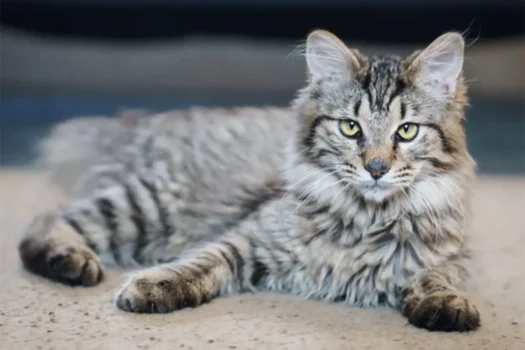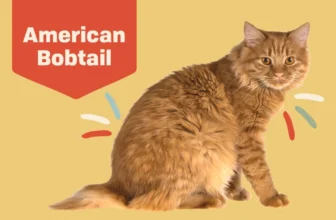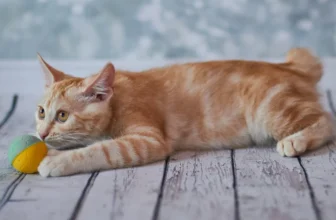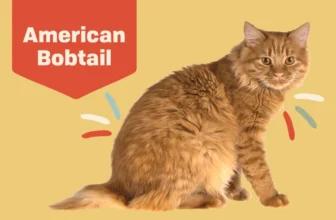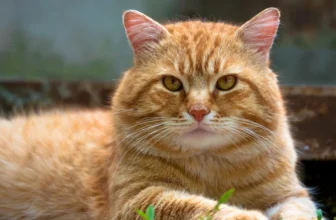It’s no secret that the American Bobtail cat breed has captured the hearts of many feline lovers. These cats are known for their distinctive bobbed tails, but their beautiful coat colors also deserve recognition. Have you ever wondered about the genetics behind these stunning coats? It’s a fascinating topic that delves into the complexity of genetic inheritance. In this article, we’ll explore everything you need to know about the genetics of coat colors in American Bobtail cats. From the basic coat color genetics to the specific colors found in the American Bobtail breed, we’ll break it all down for you. So buckle up and prepare for a journey into the fascinating world of cat genetics.
Understanding Cat Coat Genetics
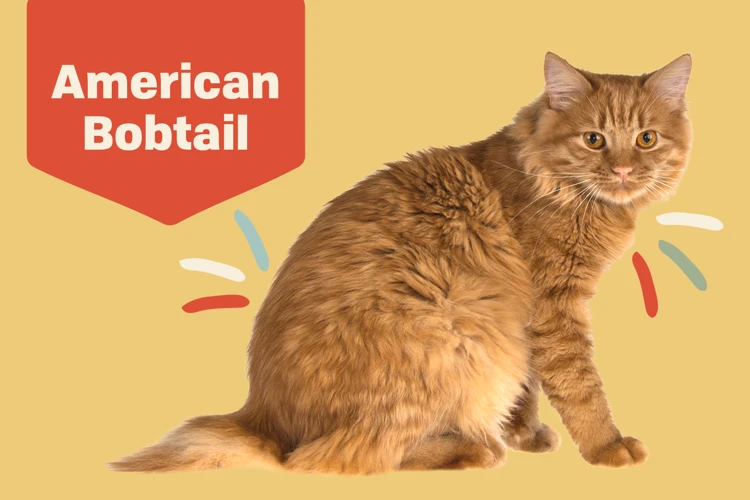
Cat coat genetics is a fascinating subject that can help unravel the mysteries behind how certain traits are passed down from generation to generation. Understanding how a cat’s coat is patterned and colored requires knowledge of basic coat color genetics, as well as how these principles are applied to distinct cat breeds such as the American Bobtail.
Basic Coat Color Genetics
The genetics of cat coat colors are determined by a series of genes that produce pigments. A cat’s coat color is determined by the distribution and quantity of these pigments. These pigments include eumelanin, which produces black and brown colors, and pheomelanin, which produces reddish and yellowish colors. These pigments are affected by other genes, such as those that determine tabby markings, white spotting, and dilution of pigment.
Cats with White Coats
Cats with solid white coats may have a dominant white gene, which inhibits the production of pigment. However, some cats with white coats may have small patches of color due to the presence of other genes that affect coat color.
Cats with Solid Coats
Cats with solid coats, such as black or blue, have a uniform distribution of pigments throughout their fur. This is typically due to the presence of genes that produce a high concentration of a certain pigment.
Cats with Bi-Color Coats
Bi-color cats have two distinct colors on their fur. This is typically due to a gene that produces a limited distribution of pigment. The other color can be any solid or tabby pattern.
Cats with Tabby Coats
Tabby cats have a unique striped or spotted pattern on their fur. The gene responsible for this pattern is thought to have evolved to help camouflage the cat in its natural environment. This type of camouflage would allow cats to blend in with natural surroundings, making it easier to catch prey and avoid predators.
For more information on tabby cats, check out our article on tabby bobtail cats.
American Bobtail Coat Colors
The American Bobtail is a breed of cat that is known for its unique tail, which is shorter than most cat tails. American Bobtails can come in a variety of coat colors, each with their own unique genetics.
Brown Tabby
The brown tabby is one of the most common coat colors for American Bobtails. This color is produced by a combination of genes that produce a warm, reddish-brown hue.
Red Tabby
Red tabby American Bobtails are less common, but still beautiful. The red coloration is produced by a gene that produces a high concentration of pheomelanin.
Black
Black American Bobtails are less common, but still striking. The black color is produced by a gene that produces a high concentration of eumelanin.
Blue
Blue American Bobtails have a blue-grey colored fur. This color is produced by a dilution gene that affects the concentration of both eumelanin and pheomelanin.
Chocolate
Chocolate American Bobtails have a rich brown color that is produced by a dilution gene that affects the production of eumelanin.
Lilac
Lilac American Bobtails have a pale lavender color that is also produced by a dilution gene.
Cinnamon
Cinnamon American Bobtails have a warm brown coloration that is produced by a combination of genes that produce a reddish-brown hue.
Fawn
Fawn American Bobtails have a pale beige coloration that is produced by a dilution gene that affects the production of both eumelanin and pheomelanin.
For more information on American Bobtail coat colors, check out our article on American Bobtail cat coat colors.
Conclusion
The genetics of coat colors in American Bobtail cats is a complex and fascinating subject. Understanding the basic principles of coat color genetics can help us better appreciate the wide variety of colors and patterns we see in our feline friends. For more information on caring for your American Bobtail’s coat, check out our article on American Bobtail coat care or our article on spotting American Bobtail coats.
Basic Coat Color Genetics
As you may know, the coat color of a cat is one of its most distinctive features. However, have you ever wondered how they end up with their specific coat color? It all comes down to genetics! It might sound complicated at first, but let’s break it down into simpler terms. Essentially, specific genes control the color and pattern of a cat’s coat, and the combination of these genes determines the final coat color. In the following sections, we’ll go over the basics of cat coat color genetics and how it relates to American Bobtail cats. If you’re interested in learning more about the American Bobtail cat breed, check out our article on American Bobtail coat colors. Let’s get started!
Cats with White Coats
Cats with white coats are aesthetically appealing, but their genetic makeup complicates the breeding process. There are a few different genetic factors that influence the production of white coats. Here are some key points to keep in mind:
- White spotting: This trait is caused by a dominant gene, which means it only takes one copy of the gene to produce the trait. White spotting can manifest in a few different ways. Cats with just a small amount of white fur may have the high white spotting phenotype, whereas cats with larger patches of white may have the piebald phenotype. Finally, cats with almost entirely white coats may have the white phenotype.
- Albinism: Albinism is a genetic condition that affects melanin production. Albinistic cats have white fur and pink eyes (due to a lack of pigment in their irises). This condition is caused by a recessive gene, which means that cats must inherit two copies of the gene – one from each parent – to develop albinism.
- White colorpoint: This unique coloration is primarily seen in Siamese and Himalayan cats. In Chinese Li Hua cats, this is caused by the W gene. It’s caused by a gene that produces a warm-colored pigment in the extremities, and a lack of pigment elsewhere. This leads to an animal with white fur and dark-colored points, such as the ears, tail, and paws.
- White mosaicism: This rare condition results in a cat having patches of white and colored fur on the same individual. This phenomenon is caused by a mutation that arises in one of the cat’s embryonic cells. As the cat develops, these cells divide and spread throughout the body, creating areas of white and colored fur in a seemingly random pattern.
Understanding these genetic quirks is crucial for breeders and cat enthusiasts alike. By digging into the genetic makeup of cats with white coats, we can better understand how different traits are inherited and passed on through generations.
Cats with Solid Coats
One of the basic coat colors in cats is solid coat color. These coats are of one color, with no patterns or stripes. Solid coats can come in many different colors, such as black, white, gray, brown, and orange. Let’s take a closer look at the genetics behind some of these solid coat colors in American Bobtail cats:
| Color | Gene | Description |
|---|---|---|
| Black | B | When a cat has two copies of the dominant B gene, it will have a black coat. |
| White | W | Cats with two copies of the W gene will have a solid white coat. |
| Gray | D | The D gene determines the density of the cat’s hair, and it also affects the color. A cat with two copies of the dominant allele D will have darker and more dense fur, resulting in a gray or blue coat. |
| Orange | O | The orange coat color is caused by the O gene, which is dominant over other color genes. If a cat has one or two copies of the O gene, it will have an orange coat. |
It’s important to note that there are several genes that affect coat color in cats, so each color can have different genetic explanations depending on the specific gene combination in the individual cat’s DNA. Understanding these genetics is essential to better understanding the coat colors found in American Bobtail cats.
Cats with Bi-Color Coats
Bi-color cat coats are a beautiful and unique phenomenon that is a result of genetics. These coats are characterized by the presence of two distinct coat colors in specific areas of the cat’s body. The two colors are usually black and white, with the white color forming a pattern on the cat’s body. Bi-color cat coats are not as common as some other coat types, but they are still well-known and adored by cat lovers worldwide.
Genetics of Bi-Color Coats
The genetics behind bi-color coats are more complex than other types of coats. Bi-color coats are a result of the interaction between three genes, the dominant white spotting gene (S), the agouti gene (A), and the non-agouti gene (a). The S gene controls the amount of white on the cat’s coat, with the dominant form of the gene leading to more white. The agouti gene controls the distribution of black pigment in the coat, with the dominant form of the gene leading to a pattern that is restricted to certain areas of the coat. The non-agouti gene controls whether or not the coat has a pattern at all, with the dominant form of the gene leading to solid-colored coats.
Patterns in Bi-Color Coats
There are several different patterns that can occur in bi-color cat coats, including the tuxedo, the cap-and-saddle, and the mask-and-mantle. The tuxedo pattern is characterized by a black coat with a white chest and stomach area. The cap-and-saddle pattern is characterized by a black coat with a white chest and a white saddle-shaped pattern on the back. The mask-and-mantle pattern is characterized by a black coat with a white chin, chest, and stomach area, with the white color appearing to form a mantle over the cat’s shoulders.
Examples of Bi-Color Coats in American Bobtail Cats
American Bobtail cats with bi-color coats are simply stunning. One example of a bi-color coat in American Bobtail cats is the brown and white tuxedo. This coat features a dominant brown color with a white chest area, making it a perfect tuxedo-like pattern. Another example is the blue and white cap-and-saddle pattern, where the cat’s back appears as if it is carrying a saddle. The American Bobtail cats with bi-color coats are truly unique and special.
To summarize, bi-color coats are a beautiful and rare type of coat in American Bobtail cats. They are the result of the interaction of three genes and can have different patterns, including the tuxedo, cap-and-saddle, and mask-and-mantle. Bi-color coats in American Bobtail cats are truly a sight to behold and are highly sought after by cat lovers worldwide.
| Coat Color | Pattern |
|---|---|
| Brown and White | Tuxedo |
| Blue and White | Cap-and-saddle |
| Black and White | Mask-and-mantle |
Cats with Tabby Coats
Tabby is one of the most common coat patterns found in cats. It is characterized by stripes, spots, or whorls on the fur. Tabby cats can come in a variety of colors, including brown, grey, black, and orange. The tabby pattern is actually a variation of the agouti gene. This gene causes the individual hairs to have bands of different colors, which give the cat its distinctive pattern. Let’s take a closer look at the different types of tabby coats in cats.
Brown Tabby: Brown tabbies are one of the most common types of tabby cats. Their coat features a mix of brown, black, and cream stripes with a distinctive “M” marking on their forehead. Some brown tabbies may have white markings on their chest and belly.
Grey Tabby: Grey tabbies, also called blue tabbies, have a coat that is mostly grey with black stripes. Their markings may be thin or thick, and their fur may be lighter or darker in certain areas.
Orange Tabby: Orange tabbies, also known as red tabbies, have a coat that ranges from pale cream to deep ginger. Their markings can be a deep red or almost black. Orange tabbies are usually male and are often considered to have a friendly, affectionate personality.
Black Tabby: Black tabby cats have a coat that is dark with black stripes. Their markings may be hard to see at first glance, but they are still present. Some black tabbies may have a red or orange tint to their fur in certain areas.
Tabby and White: Some tabbies may have white markings on their chest, belly, or paws. These cats are known as tabby and white cats. The white patches on their coat can vary in size and shape, and may be positioned in different areas.
To better understand the different types of tabby coats, check out the table below:
| Tabby Coat Color | Distinctive Features |
|---|---|
| Brown | Mix of brown, black, and cream stripes; “M” marking on forehead |
| Grey | Mostly grey with black stripes; light or dark fur in areas |
| Orange | Pale cream to deep ginger color; red or black markings; usually male |
| Black | Dark coat with black stripes; may have red or orange tint in areas |
| Tabby and White | White patches on chest, belly, or paws; varying sizes and shapes |
Tabby cats are a popular choice for pet owners due to their unique and beautiful coat patterns. The genetics behind tabby coats are still being studied, but it is clear that the agouti gene plays a major role in determining the final pattern of the cat’s fur. Whether you prefer a brown, grey, orange, or black tabby, these cats are sure to add a bit of personality and charm to your home.
American Bobtail Coat Colors
When it comes to American Bobtail cats, their coat colors can vary greatly. Many breeders aim for certain color patterns or variations, but it all comes down to genetics.
Brown Tabby: This is perhaps the most common coat color for American Bobtail cats. The brown tabby pattern consists of distinct stripes on a tan or brown background. The intensity of the color can differ from cat to cat.
Red Tabby: A red tabby American Bobtail has a reddish-orange coat with stripes of a darker red. This color is the result of a recessive gene that causes a dilution of the black pigment.
Black: Black American Bobtail cats are a striking sight, with their solid black coats. The black color is dominant, meaning that if one parent is black, the offspring will also be black.
Blue: Blue American Bobtail cats have a grayish-blue coat that can range in shade from light to dark. This color is the result of a dilution gene that affects the black pigment.
Chocolate: A brownish-red coat, the chocolate color is caused by a recessive gene that dilutes the black and red pigments.
Lilac: Another dilution color, lilac American Bobtail cats have a pale, pinkish-gray coat.
Cinnamon: Cinnamon American Bobtail cats have a warm, reddish-brown coat. This color is caused by a recessive gene that dilutes both the black and the red pigments.
Fawn: Fawn-colored American Bobtail cats have a light tan coat. This color is also the result of a dilution gene.
Other Colors: In addition to the colors listed above, American Bobtail cats can also have white, cream, and silver coats. Additionally, there are a number of rare colors and patterns that might pop up from time to time.
Understanding the genetics behind coat colors in American Bobtail cats can help breeders produce the desired colors and patterns in their litters. As with any breed of cat, the coat color is just one aspect of what makes each American Bobtail unique and special.
Brown Tabby
When it comes to American Bobtail cats, one of the most common coat colors you’ll come across is a beautiful blend of browns and a characteristic tabby pattern. This unique coat color, which consists of different shades of brown and black stripes with touches of white, is referred to as a brown tabby. The fascinating thing about this color is that it has its own unique genetic makeup, determining the way that the colors and patterns appear on the cat’s fur. Let’s take a closer look at the genetics behind the brown tabby coat color in American Bobtail cats.
Red Tabby
When it comes to American Bobtail cats, the red tabby coat color is a popular choice among cat owners. The genetic makeup of a red tabby cat is fascinating and worth exploring.
The Genetics of Red Tabby Coat in American Bobtail Cats
Red tabby coat color is achieved when a cat has a dominant “O” allele on its X chromosome. This allele results in the cat producing a pigment called phaeomelanin, which is responsible for the reddish-orange color. The tabby pattern is created when the agouti gene produces a specific pattern called the “mackerel tabby” pattern. This pattern results in narrow, vertical stripes on the cat’s body, making red tabby American Bobtail cats easily recognizable.
Below is a table that summarizes the genes involved in creating the red tabby coat color in American Bobtail cats.
| Gene | Allele | Effect on Coat Color |
|---|---|---|
| X Chromosome | OO | Produces phaeomelanin, resulting in a red/orange coat |
| Agouti Gene | AA | Produces the mackerel tabby pattern |
It’s important to note that the red tabby coat color can vary in intensity and hue, depending on the specific genes and alleles inherited by the kitten. Additionally, the tabby pattern itself can also vary in width and spacing, resulting in unique and beautiful coats in every American Bobtail cat.
Understanding the genetics behind the red tabby coat color in American Bobtail cats can offer valuable insight into the breeding and selection of these beloved pets. With this knowledge, breeders can aim to produce cats with specific coat colors and patterns, while pet owners can appreciate the beauty and uniqueness of their furry companions.
Black
When it comes to American Bobtail cats, black may seem like a simple and common coat color, but there is actually a lot of interesting genetics behind it.
Basic Genetics of Black Coats: In order for a cat to have a black coat, they must have two copies of the dominant black gene, which is represented by the letter B. This means that even if a cat only inherits one copy of the B gene, they will still express black coloring.
Other Factors Affecting Black Coats: While the B gene is the most important factor in determining a black coat, other genes can also play a role in the shade and pattern of the coat. For example, the Agouti gene can impact whether a black cat has a solid black coat or a more banded or striped appearance. Additionally, the Tabby gene can result in different varieties of black tabbies.
Here is a table summarizing the genetic possibilities for black American Bobtail cats:
| Genotype | Phenotype |
|---|---|
| BB | Solid black coat |
| Bb | Solid black coat |
| bb | Not possible for American Bobtail cats |
| B- with Agouti gene | Black tabby coat |
| B- with Tabby gene | Various black tabby patterns |
As you can see, there are multiple genetic possibilities for black coats in American Bobtail cats. Whether a cat has a solid black coat, a black tabby pattern, or something in between, their genes are responsible for creating the unique and beautiful coat we admire.
Blue
The blue coat color in American Bobtail cats is a unique and stunning shade that is highly sought after by many cat lovers. This color is the dilute form of the black color gene and is caused by a mutation that affects the distribution and production of pigment in the coat.
When breeding two American Bobtail cats that carry the blue gene, there’s a chance of producing blue kittens. The following table summarizes the different possible outcomes (assuming both parents carry the blue gene):
| Probability | Genotype | Phenotype |
|---|---|---|
| 25% | BB | Non-dilute (black) |
| 50% | Bb | Dilute (blue) |
| 25% | bb | Non-agouti (solid blue) |
As seen in the table above, there’s a 50% chance of producing blue kittens. However, if both parents are blue, all the kittens will be blue as they both have two copies of the blue gene.
Additionally, it’s important to note that the blue coat color in American Bobtail cats can also come with tabby patterns or white markings. This adds even more variety to the already wide range of coat colors found in this amazing breed.
The blue coat color in American Bobtail cats is a beautiful and unique feature that many cat lovers adore. Its genetics may seem complicated, but with careful breeding and attention to detail, breeders can produce stunning blue American Bobtails with ease.
Chocolate
When it comes to the coat colors of American Bobtail cats, “Chocolate” is one of the more unique and rare colors. This coloring is the result of a recessive gene that tones down the darker shades of Black or Brown, resulting in a beautiful, rich, chocolate-brown color.
To understand this coat color’s particulars, it’s worth taking a look at the genetic makeup of these felines. In general, the Chocolate coloring occurs when both parents contribute a gene for the brown coat color, denoted as “b.” If a cat inherits one “B” gene and one “b” gene, they will have the genetically dominant Brown coat color. But when a cat inherits two recessive “b” genes, they will have the Chocolate coat coloring.
Visually, Chocolate Bobtail cats have a luscious, silky coat with a warm brown hue that is often described as similar to dark chocolate. This color is most prominent in the cat’s fur, but it can also be present in their eyes and nose leather.
To get a sense of what a Chocolate American Bobtail cat might look like, here is a table detailing the breed’s most common coat colors and patterns:
| Coat Color | Appearance |
|————–|————–|
| Brown Tabby | Brown coat with bold, black stripes or spots |
| Red Tabby | Red coat with stripes or spots that can range from a light ginger to deep orange-brown |
| Black | Solid black coat with little to no visible striping |
| Blue | Grayish-blue coat with a subtle stripe pattern |
| Lilac | Pinkish-gray coat with a muted stripe pattern |
| Cinnamon | Reddish-brown coat with a subtle stripe pattern |
| Fawn | Light beige or tan coat with a darker stripe pattern |
| Chocolate | Brown coat with a warm hue similar to dark chocolate |
| Bi-color | Two distinct color patterns, often white combined with one of the above colors |
Chocolate American Bobtail cats might be rare, but they are remarkable in their unique coloring and playful, affectionate personality. Whether you’re a seasoned cat owner or looking to adopt your first feline friend, the American Bobtail breed with its wide range of coat colors and patterns, is always a great choice.
Lilac
One of the rarest and most beautiful coat colors for American Bobtail cats is the Lilac. This color is also known as lavender, and it is a diluted version of the Chocolate color. In fact, Lilac American Bobtail cats are the result of the Chocolate gene being diluted twice.
The Lilac color is a soft, warm, and muted greyish-pink hue, often described as similar to pale lilac flowers. This gentle color is especially captivating and makes Lilac American Bobtail cats stand out from others.
Lilac American Bobtail cats have a white undercoat, and their fur is soft and short-haired. Their eyes are a striking green or yellow, which makes them even more unique and attractive.
Here are the genetics behind the Lilac coat color in American Bobtail cats:
Possible Genotypes:
| Genes from Father | Genes from Mother | Lilac Coat Color Probability |
|---|---|---|
| Bb dd | Bb dd | 25% |
| BB dd or Bb Dd | Bb dd or bb Dd | 50% |
| BB Dd | bb Dd | 25% |
As shown in the table, Lilac American Bobtail cats inherit one copy of the Chocolate gene (b) from each parent, and two copies of the Dilute gene (dd) from both parents. Because of this, there is a 25% chance that both parents pass on the recessive Chocolate and Dilute genes, resulting in a Lilac coat color.
The Lilac American Bobtail cat is an incredibly rare and beautiful creature, with a soft and muted coat that is sure to capture anyone’s attention. By understanding the genetics behind this unique coat color, breeders and cat enthusiasts alike can appreciate the science and complexity that goes into producing such a stunning feline.
Cinnamon
Cinnamon is a rare and unique color for American Bobtail cats. This color is produced by a recessive gene known as the “b” gene. This gene causes a dilution of the black pigment, resulting in a warm, reddish-brown coat.
The cinnamon color is often mistaken for a lighter shade of the chocolate hue, but the difference between the two is clear when compared side by side. While chocolate has a cool-toned appearance, cinnamon has red and warm undertones.
Below is a table summarizing the genetic makeup and physical characteristics of cinnamon American Bobtail cats:
| Genetic Makeup (BB, Bb, or bb) | Coat Color | Eye Color |
|---|---|---|
| bb | Cinnamon | Green or Gold |
Cinnamon American Bobtail cats have a distinctive appearance with their warm-toned, reddish-brown coat and striking green or gold eyes. This color, while rare, is highly valued by American Bobtail enthusiasts and breeders. If you’re looking for a unique and striking cat with a warm and friendly personality, a cinnamon American Bobtail might just be the perfect fit for you.
Fawn
Fawn coat color in American Bobtail cats is a rare and beautiful variant that is highly coveted among cat enthusiasts. This color is the result of a combination of genes that determine the amount and distribution of pigments in the hair shafts. Fawn cats have a pale pinkish-brown coat with faint tabby markings, giving them a delicate appearance.
The fawn color is primarily caused by a dilution gene that lightens the brown color to a cream or buff hue. This gene is often paired with a tabby pattern gene that introduces darker stripes or spots on the coat. Fawn American Bobtail cats may also have white patches on the chest, belly, and paws, adding to their unique appearance.
In terms of genetics, fawn cats have the genotype dd, which means they have two dilution genes that cause the color dilution. It is also possible for them to carry other genes that affect coat color and pattern, such as the agouti gene, which can create banding on individual hairs.
Here is an overview of the genetic components that contribute to the fawn coat color in American Bobtail cats:
| Gene | Genotype | Phenotype |
|---|---|---|
| Dilution gene | dd | Lightened brown coat color |
| Tabby pattern gene | TT or Tt | Dark stripes or spots on the coat |
| Agouti gene | Aa or aa | Banding on individual hairs |
The fawn coat color in American Bobtail cats is a result of multiple genetic factors that interact to create a unique and fascinating appearance. Breeders carefully select for these traits to maintain the purity and beauty of the fawn color.
Other Colors
Apart from the common coat colors found in American Bobtail cats, there are also some rarer color variations that are worth mentioning. These colors may be the result of genetic mutations or rare combinations of genes.
Golden: A unique combination of yellow and orange shades that creates a shiny, metallic-like coat. The coat color is caused by a recessive gene that is not often observed in American Bobtail cats.
Silver: A striking coat color that is caused by a dominant gene. Silver American Bobtail cats have pale, silvery fur with black markings.
Smoke: Smoke-colored cats have a unique coloration that gives them a frosted or smoky appearance. This comes from a variation in the way the cat hair is pigmented, which causes a gradient from black to white on each hair.
Calico: Calico cats have a white base coat with patches of black, orange, and sometimes cream. Calico patterns are the result of a gene that causes random patches of color. It’s worth noting that calico cats are almost always female.
Tortoiseshell: Tortoiseshell cats have coats consisting of black, orange, and sometimes cream color patches. These colors are the result of a gene that causes random patches of color. It’s worth noting that tortoiseshell cats are almost always female.
Points: Points refer to a coat pattern found in Siamese cats, where the extremities are darker than the rest of the coat. Pointed American Bobtails may have dark ears, paws, and tails in contrast with a lighter coat color.
It’s important to note that while coat color can be a fascinating topic, it’s not the only defining characteristic of a cat. It’s also essential to pay attention to their personality, behavior, and physical health when looking for a new pet.
Conclusion
After delving into the genetics of coat colors in American Bobtail Cats, it’s clear that there is a complex interplay between genetic factors that determine the final color and pattern of their coats. From basic coat color genetics to bi-color and tabby patterns, there are a variety of factors that contribute to the appearance of an American Bobtail’s coat.
It’s important to note that while breeders can selectively breed for certain coat colors and patterns, it’s ultimately up to chance which traits will be expressed in any given litter. Additionally, coat color and pattern do not affect the temperament or personality of an American Bobtail Cat.
Overall, understanding the genetics behind American Bobtail Cat coats can help breeders and owners alike better appreciate the beauty and diversity of these beloved felines. Whether it’s a striking brown tabby or a rare cinnamon coat, each American Bobtail’s coat offers a unique glimpse into the intricate world of cat genetics. It’s truly a wonder of nature that such a wide range of coats can be produced from just a few simple genetic factors.
Frequently Asked Questions
How many genes determine a cat’s coat color?
Multiple genes determine a cat’s coat color, which can vary depending on the breed and individual cat.
Can cat coat colors change over time?
No, a cat’s coat color is determined by genetics and will not change over time.
What is a tabby cat?
A tabby cat refers to a cat with a distinctive coat pattern that includes swirling stripes, spots, or blotches.
What is a bi-color cat?
A bi-color cat has a coat that is mostly white with patches of another color on the face, tail, and/or body.
What is a solid color cat?
A solid color cat has a coat that is all one color with no markings or patterns.
How can you tell the difference between a brown tabby and a cinnamon tabby?
A brown tabby has black or dark brown stripes on a lighter brown background, while a cinnamon tabby has lighter orange or reddish-brown stripes on a warmer brown background.
What is the rarest coat color for an American Bobtail?
The rarest coat color for an American Bobtail is fawn, which is a pale tan or beige color.
Can two cats with the same coat color have different colored offspring?
Yes, it is possible for two cats with the same coat color to have different colored offspring due to variations in their genetics.
What is the most common coat color for an American Bobtail?
The most common coat color for an American Bobtail is brown tabby.
Can coat color affect a cat’s health or behavior?
No, coat color does not have a direct impact on a cat’s health or behavior. However, certain breed traits may be associated with certain coat colors.

